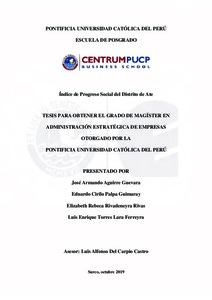| dc.contributor.advisor | D´Alessio Ipinza, Fernando Antonio | |
| dc.contributor.author | Aguirre Guevara, José Armando | |
| dc.contributor.author | Palpa Guimaray, Eduardo Cirilo | |
| dc.contributor.author | Rivadeneyra Rivas, Elizabeth Rebeca | |
| dc.contributor.author | Torres Lara Ferreyra, Luis Enrique | |
| dc.date.accessioned | 2020-02-05T22:58:42Z | |
| dc.date.available | 2020-02-05T22:58:42Z | |
| dc.date.created | 2019-10 | |
| dc.date.issued | 2020-02-05 | es_ES |
| dc.identifier.uri | http://hdl.handle.net/20.500.12404/15862 | |
| dc.description.abstract | Las comunidades buscan desarrollarse con el fin de que sus ciudadanos logren una
calidad de vida que les permita satisfacer sus necesidades básicas, disponer de fundamentos
que les brinden bienestar y contar con oportunidades que les permitan alcanzar su máximo
potencial. En concordancia a ello, el Índice de Progreso Social es una medición holística del
desempeño social y ambiental de una comunidad, ya que abarca dimensiones como
necesidades humanas básicas, fundamentos del bienestar y oportunidades, cada dimensión
está conformada por cuatro componentes y estos, a su vez, con variables acordes a cada
componente (Stern, Wares & Epner, 2017).
La presente investigación tiene como objetivo obtener el Índice de Progreso Social del
distrito de Ate, en el año 2019, así como de sus tres macrozonas, para este fin se utilizó la
metodología del Social Progress Imperative (Stern, Wares & Epner, 2017) mediante un
enfoque cuantitativo con un diseño no experimental transeccional y un alcance exploratorio
descriptivo, asimismo, como fuente primaria, se utilizó la encuesta proporcionada por
CENTRUM PUCP como herramienta para el levantamiento de información en el distrito y
sus macrozonas, adicionalmente se consultaron fuentes de información secundaria de
entidades públicas y privadas. Finalmente, se analizó toda la información recabada de las
ambas fuentes para la obtención del Índice de Progreso Social. El resultado del IPS para el
distrito de Ate según la escala de 0 (extremo bajo) a 100 (muy alto) planteada en el IPS del
Distrito de Santiago de Surco (CENTRUM Católica, 2017a) fue de 55.40 puntos, lo cual
evidencia un nivel medio bajo de progreso social, el resultado para la macrozona 1 fue de
61.91, siendo un valor medio bajo, mientras que los valores obtenidos en la macrozona 2 y 3
fueron de 50.96 y 52.85, lo cual indica un nivel bajo de progreso social. Estos resultados
evidencian que en el distrito de Ate aún existen carencias y brechas que impiden que sus
ciudadanos alcancen su máximo potencial. | es_ES |
| dc.description.abstract | The communities seek to develop for their citizens to achieve a quality of life that
allows them to meet their basic needs, to have foundations that provide them with well-being
and to have opportunities that allow them to reach their full potential. Accordingly, the Social
Progress Index is a holistic measurement of the social and environmental performance of a
community, since it encompasses dimensions such as basic human needs, fundamentals of
well-being and opportunities, each dimension is made up of four components and these, in
turn, with variables according to each component.
The objective of this research is to obtain the Social Progress Index of the district of
Ate in 2019, as well as its three macro zones, for this purpose, the Social Index Imperative
methodology was used through a quantitative approach with a non-experimental crosssectional
design and an exploratory and descriptive scope, the survey provided by
CENTRUM PUCP was also used as a tool, for the collection of information in the district and
its macrozones, the results of this survey represented the primary source, additionally,
secondary information sources of public and private entities were consulted.
Finally, all the information collected from primary and secondary sources was
analyzed to obtain the Social Progress Index. The result of the IPS calculated for the district
of Ate was 55.40 points, which evidences a low average level of social progress, the result for
macrozone 1 was 61.91, being a low average value, while the values obtained in the
macrozone 2 and 3 were 50.96 and 52.85, which indicates a low level of social progress.
These results show that there are still shortages and gaps in the Ate district that prevent its
citizens from reaching their full potential. | es_ES |
| dc.language.iso | spa | es_ES |
| dc.publisher | Pontificia Universidad Católica del Perú | es_ES |
| dc.rights | Atribución-NoComercial-SinDerivadas 2.5 Perú | * |
| dc.rights | info:eu-repo/semantics/openAccess | es_ES |
| dc.rights.uri | http://creativecommons.org/licenses/by-nc-nd/2.5/pe/ | * |
| dc.subject | Indicadores sociales--Perú--Ate (Lima : Distrito) | es_ES |
| dc.subject | Indicadores económicos--Perú--Ate (Lima : Distrito) | es_ES |
| dc.subject | Investigación cuantitativa | es_ES |
| dc.title | Indice de progreso social del distrito de Ate | es_ES |
| dc.type | info:eu-repo/semantics/masterThesis | es_ES |
| thesis.degree.name | Magíster en Administración Estratégica de Empresas | es_ES |
| thesis.degree.level | Maestría | es_ES |
| thesis.degree.grantor | Pontificia Universidad Católica del Perú. CENTRUM | es_ES |
| thesis.degree.discipline | Administración Estratégica de Empresas | es_ES |
| renati.advisor.dni | 41319855 | |
| renati.author.dni | 41230279 | |
| renati.author.dni | 41643728 | |
| renati.author.dni | 10673439 | |
| renati.author.dni | 42576518 | |
| renati.discipline | 413307 | es_ES |
| renati.level | https://purl.org/pe-repo/renati/level#maestro | es_ES |
| renati.type | https://purl.org/pe-repo/renati/type#tesis | es_ES |
| dc.publisher.country | PE | es_ES |
| dc.subject.ocde | https://purl.org/pe-repo/ocde/ford#5.02.04 | es_ES |






